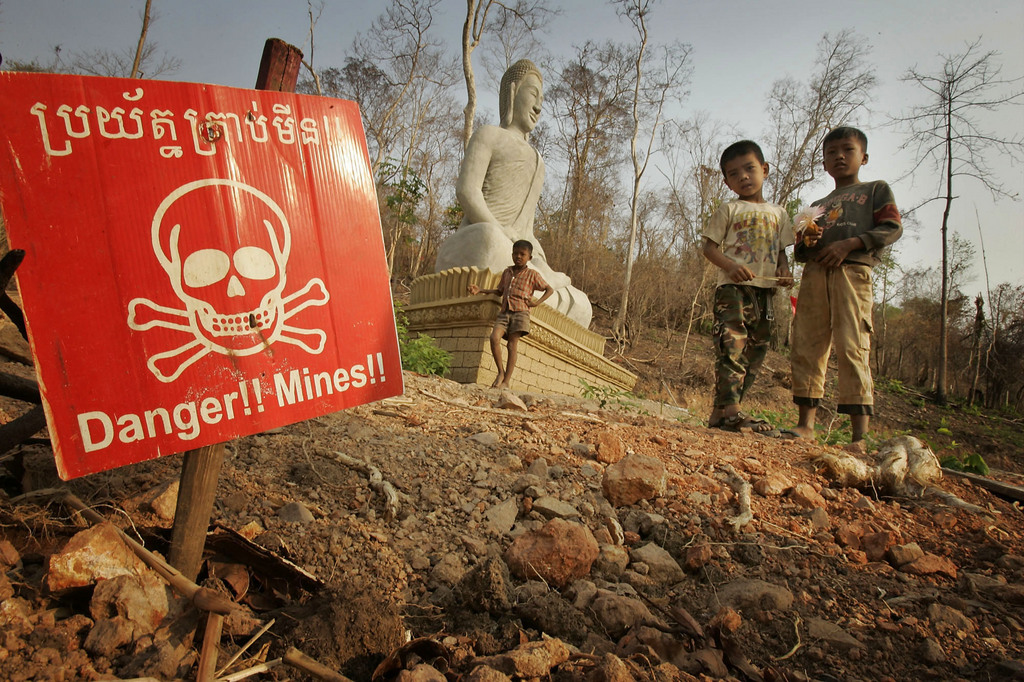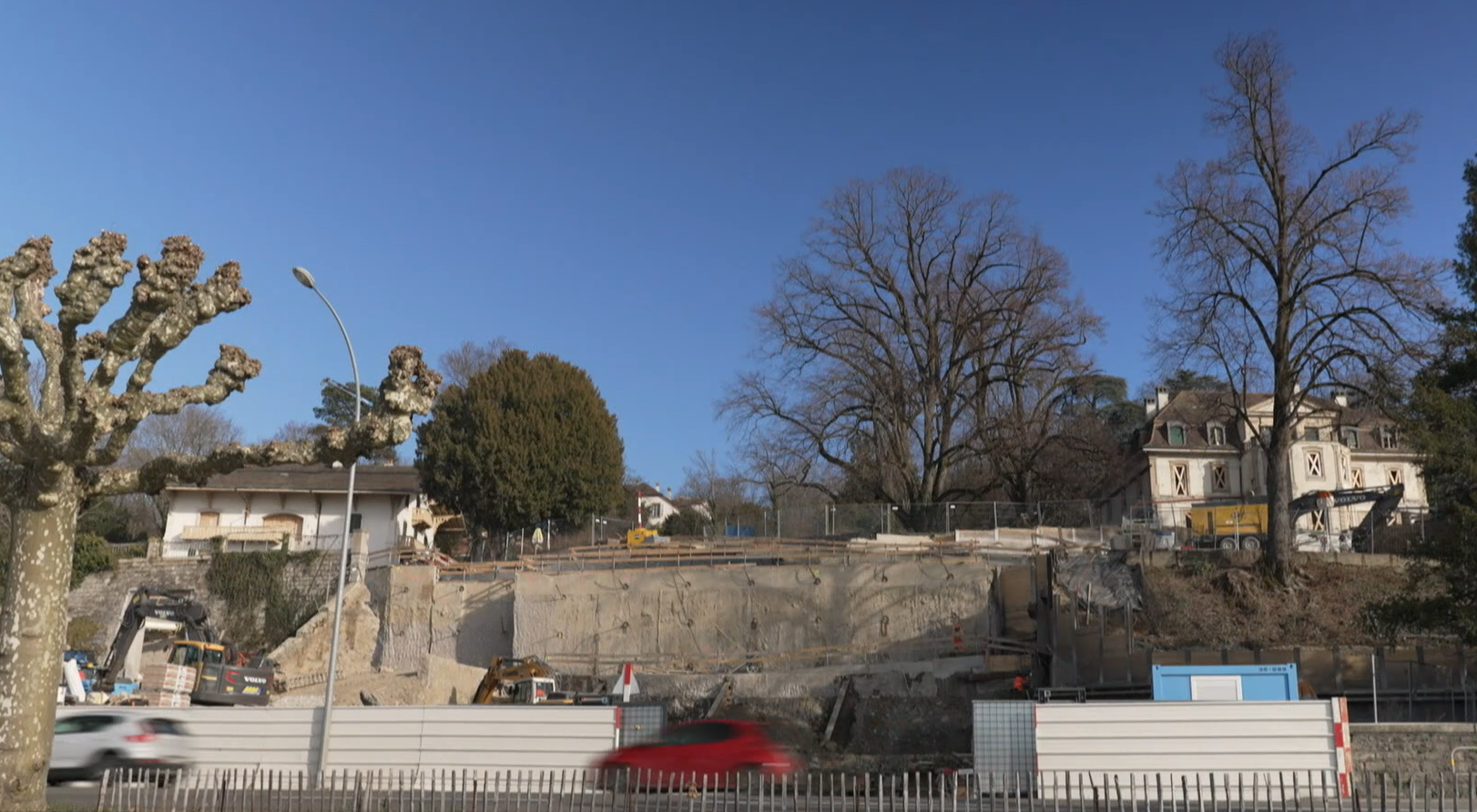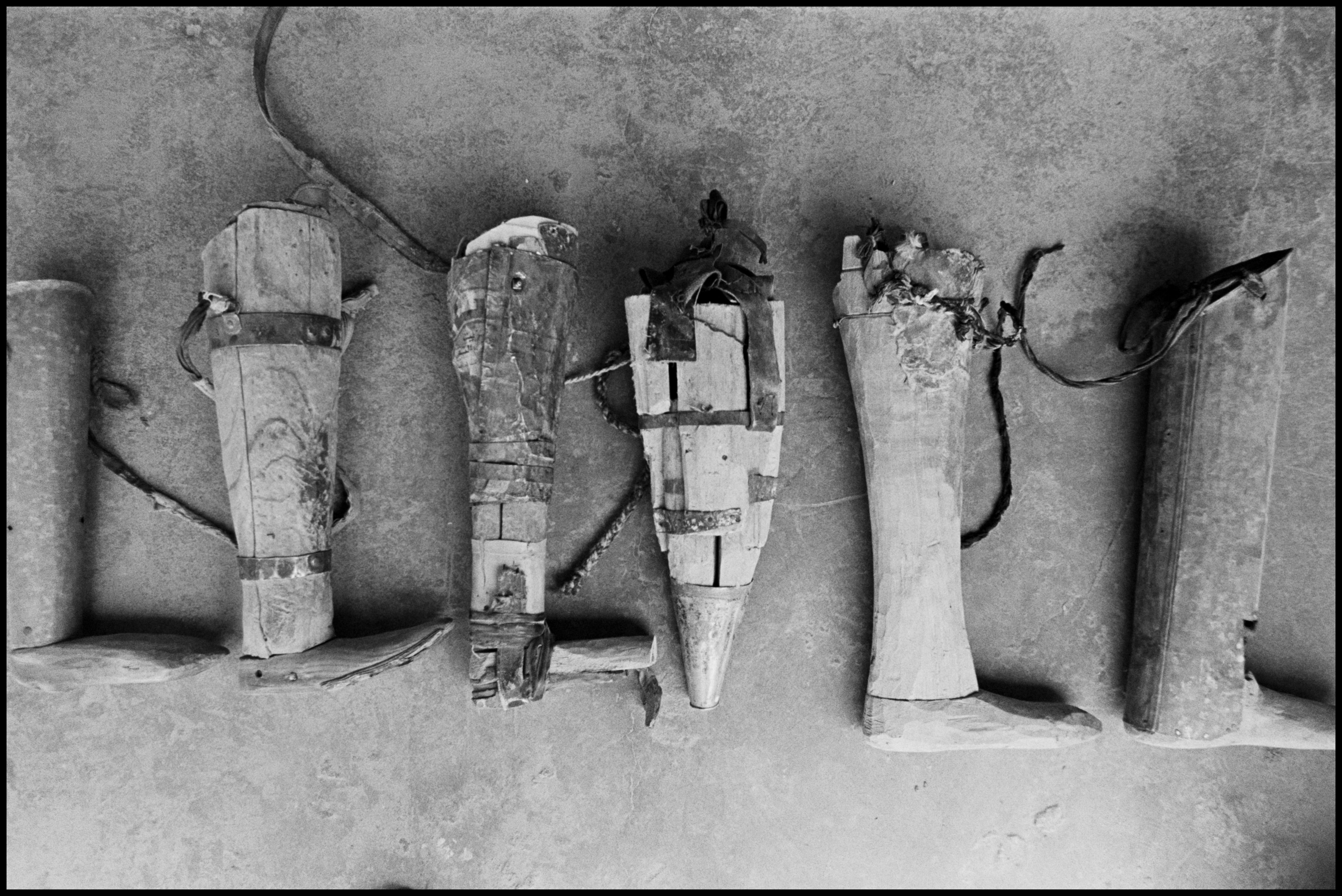Landmines: the legacy of war that goes on killing

Despite progress in recent years, anti-personnel mines are still a scourge in more than 70 countries. Coordinating the disposal of all explosives left behind by wars is the job of the Geneva International Centre for Humanitarian Demining.
“There is a vast difference between nuclear weapons and landmines. The former are weapons of the rich, the latter of the poor. Yet they also have something in common: they are weapons which cast the shadow of war also across peace.”
With these words the 1997 Nobel Peace Prize was awarded to the International Campaign to Ban Landmines. Fifteen years later, these cheap invisible engines of destruction are still a cause of suffering and exile.
“There is a victim about every two hours,” says Jacqueline Raemy Bessa, spokesperson of the Swiss section of Handicap International, an organisation active in demining. It is estimated that anti-personnel mines have injured or killed more than a million people since 1975. Most of them have been civilians.
Apart from endangering life and limb, these weapons make useless vast areas that could be exploited for agriculture, thus preventing economic and social development. They also hinder the return of displaced populations and hold back aid and reconstruction work.
More than a third of the countries on the planet have been affected by anti-personnel mines, cluster bombs or other kinds of unexploded ordnance, noted Pascal Rapillard of the Geneva International Centre for Humanitarian Demining (GICHD).
“In Laos, which is one of the most affected countries, only 0.2 per cent of the area thought to be contaminated was cleared in 2010. It will take a century to finish the job,” he told swissinfo.ch.
Nevertheless, he insisted, great strides had been made in recent years. “Anti-personnel mines are not an endless problem.”
Ottawa Convention
Created in 1998, the GICHD brings together scores of independent experts working on the problem of mines. “The goal is to eliminate mines, unexploded ordnance and dangerous arms dumps,” Rapillard explained.
A resource for information and consulting, the Geneva centre is one of the partners of the United Nations in carrying out national demining operations.
“We work out international standards and help countries to form a strategy,” he said.
This international centre was founded at the initiative of Switzerland during negotiations for the Ottawa Convention. This treaty bans the use, storage, production and transfer of anti-personnel mines.
The countries who have signed – currently 160 – have committed themselves to destroy their own stocks and to clear any minefields. Switzerland, one of the first signatories, got rid of its own mines in 1999, the year the treaty came into effect.
The task of GICHD is to assist signatory states to fulfil their responsibilities under the treaty, according to Rapillard.
Fewer victims
For those active on the ground (NGOs, voluntary associations, the military etc.), the difficulties involved in demining operations can be enormous.
Vast regions are hard to access and often there are no maps of where the mines were laid – such as in Afghanistan. What is more, not all governments seem to have the political will to clear their territory, according to Handicap International.
Nevertheless, the progress achieved over the past 20 years has been exceptional, Rapillard stressed. “Decisions at diplomatic and political level have been followed up by concrete operations on the ground. This is a really unusual development, especially in the context of disarmament.”
Thanks to the Ottawa Convention, thousands of square miles of ground have been cleared of mines, 45 million anti-personnel mines have been disposed of, and trade in these weapons has practically ceased, he said.
“In two decades, the estimated number of victims has gone down from 20,000 a year to 5,000 a year. Countries like Burundi and Jordan are practically mine-free.”
Stigmatised
A real change in attitudes has been observed too, he said. “In the 1980s, anti-personnel mines were considered quite legitimate weapons. Proposing to get rid of them altogether would have seemed an absurd idea. Today, except for a handful of countries, the use of mines is stigmatised: no state would now dare to admit that it uses them.”
Although the United States has not signed the Ottawa treaty, it has not used them for ten years or more, Rapillard said. It is hoped the International Convention on Cluster Bombs, which came into force in 2010, will have the same stigmatising effect.
“Even governments which do not sign up to it will give up using these weapons for fear of international condemnation,” he said.
The GICHD has established two priorities for its future strategy: to improve the competence of national authorities, and to establish greater clarity on the true dimensions of the problem.
“We may know that a particular country is affected, but we do not know exactly how many pieces of unexploded ordnance there are and where they are”, explains Rapillard.
Overall treaty
In the past, when methods of investigation were not very precise, there was a tendency to overestimate the size of the contaminated areas. From a study of 15 demining operations in 2004, it emerged that out of 292 square kilometres reclaimed, only two per cent actually contained mines or other unexploded ordnance.
According to Rapillard, there is a need to clarify the various approaches so as to whittle down the suspect areas. That should help to avoid wasting funds and resources. All the groups involved in demining should therefore adopt common practices, he says. “Information needs to be better managed.”
The GICHD hopes that one day an overall treaty will be feasible which includes all explosive weapons. It could be based on the work of the International Network on Explosive Weapons (INEW), a collective of NGOs which is calling for stricter rules about bombing in inhabited areas.
“We’re heading towards a situation in which war will be more and more disciplined,” Rapillard said. “One day, going to war itself will be thought a barbarous thing to do.”
These were first used on a large scale in the Second World War. The goal was to protect strategic areas (borders, bridges, military bases) and to inhibit the movement of enemy armies.
The main feature of these weapons is that they are designed to maim, not to kill. In time, their use was extended to the civilian population to terrorise whole communities and block access to agricultural land.
It is thought that since the 1970s 110 million anti-personnel mines have been laid. The countries contaminated, or suspected to be, are 72 in number. Among the most affected are Afghanistan, Cambodia, Laos, Angola, Iran, Iraq and Croatia.
170 million mines are currently stored in military arsenals, according to Handicap International.
Twelve countries who have not joined the Ottawa Convention reserve the right to produce mines: China, Cuba, India, Iran, Myanmar, North Korea, South Korea, Pakistan, Russia, Singapore, United States and Vietnam. Only three (India, Pakistan and Myanmar) are actually producing them.
According to Handicap International, four countries used these weapons in 2012: Israel, Myanmar, Syria and Libya.
Victims of mines numbered 4,191 in 2010 (5,502 in 2008).
In 2010, 200 sq km of minefields were cleared (160 sq km in 2008).
(Sources: Landmine Monitor, United Nations)
In 1997, Switzerland was among the first countries to sign the Convention forbidding the use, storage, production and transfer of anti-personnel mines (Ottawa Convention). The text was ratified by the Swiss parliament in 1998.
In 2008, Bern signed the Convention forbidding the use, stockpiling, production and transfer of cluster munitions (Oslo Convention). Ratification is pending.
As part of its anti-mines strategy 2012-2015, Switzerland assigns SFr16 million ($16.4 million) a year to dispatch experts and carry out projects to deal with anti-personnel mines, cluster bombs and other unexploded ordnance. About half this funding goes to the Geneva International Centre for Humanitarian Demining.
The Swiss Agency for Development and Cooperation has committed itself to activities in humanitarian demining, among which is distributing information on the dangers of mines, and aid to victims.
(Translated from Italian by Terence MacNamee)

In compliance with the JTI standards
More: SWI swissinfo.ch certified by the Journalism Trust Initiative










You can find an overview of ongoing debates with our journalists here . Please join us!
If you want to start a conversation about a topic raised in this article or want to report factual errors, email us at english@swissinfo.ch.